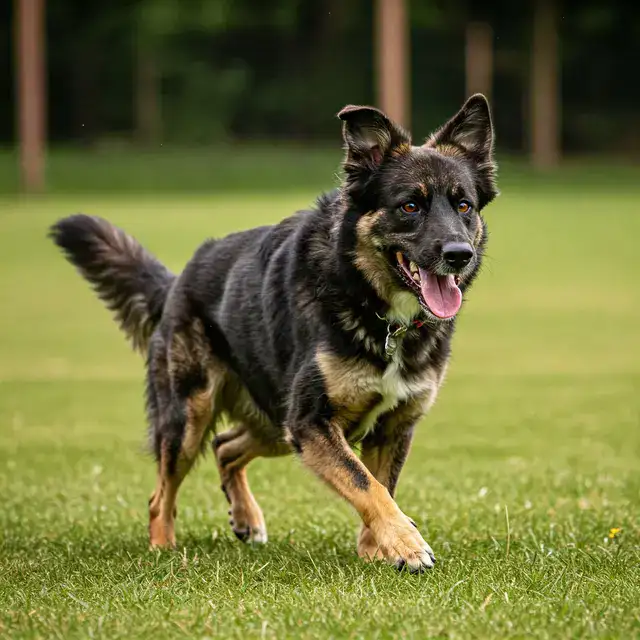The Shollie—a cross between the German Shepherd and Border Collie—combines the best traits of two legendary working breeds. Known for their intelligence, loyalty, and boundless energy, Shollies excel as family companions, service dogs, and agility champions.
Table of Contents
Quick Facts
| Trait | Details |
|---|---|
| Height | 21–29 inches |
| Weight | 70–80 lbs |
| Lifespan | 13–15 years |
| Coat | Double coat (moderate to heavy shedding) |
| Temperament | Loyal, energetic, highly trainable |
| Best For | Active families, experienced dog owners |

Shollie History and Origin
The Shollie is a designer dog breed developed in the 1990s to merge the German Shepherd’s protective instincts with the Border Collie’s herding agility. While not recognized by the AKC, they’re prized by hybrid enthusiasts for their versatility.
Parent Breeds
- German Shepherd: Bred in Germany for police/military work.
- Border Collie: Developed in Scotland/England for sheep herding.
Shollie Appearance
German Shepherd Border Collie mix inherit physical traits from both parents:
- Coat: Often a mix of black, tan, or merle patterns.
- Build: Athletic, with a muscular frame and alert posture.
- Eyes: Piercing gaze, commonly brown or blue (if merle-influenced).
Pro Tip: DNA tests like Embark can predict coat types in puppies.
Shollie Temperament: What to Expect
Family Friendliness
- Pros:
- Devoted to families; excellent with older children.
- Natural protectors (German Shepherd genes).
- Cons:
- May herd small kids or pets (Border Collie instinct).
- Prone to separation anxiety.
Adaptability
- Apartment Living: Possible with 2+ hours of daily exercise.
- Climate Tolerance: Thrives in cooler weather; monitor for overheating in summer.
Border Collie German Shepherd mix Health and Lifespan
Common Health Issues
- Hip Dysplasia (30% risk): Common in large breeds.
- Bloat (GDV): Life-threatening; feed smaller meals.
- Epilepsy: Affects 15% of Shollies (UC Davis Veterinary Genetics Lab).
Maximizing Lifespan
- Diet: High-protein, low-grain foods like Blue Buffalo Wilderness.
- Exercise: Daily mental + physical stimulation.
- Vet Care: Annual hip/elbow screenings.
Shollie Care Guide
Grooming Needs
- Brushing: 3–4x weekly with a Furminator.
- Bathing: Every 6–8 weeks using oatmeal shampoo.
- Shedding: Heavy in spring/fall—invest in a robot vacuum!
Feeding Requirements
| Age | Daily Calories | Food Type |
|---|---|---|
| Puppy | 1,500–1,800 | Large-breed puppy formula |
| Adult | 1,200–1,500 | High-protein adult kibble |
| Senior | 1,000–1,200 | Joint-support blends |

Training Your Shollie
Training Tips
- Start obedience training at 8–10 weeks.
- Use positive reinforcement (treats, praise).
- Avoid harsh methods—Shollies are sensitive.
Advanced Skills
- Agility courses
- Scent detection
- Service tasks (e.g., mobility support)
Exercise Needs
Shollies need 2+ hours of daily activity:
- Physical: Hiking, fetch, dog sports.
- Mental: Puzzle toys, hide-and-seek, training drills.
Burnout Alert: Without exercise, they’ll chew, dig, or bark excessively.
Shollie Puppies: What to Know
- Cost: $800–$2,500 from reputable breeders.
- Red Flags: Avoid breeders who won’t show health clearances.
- Socialization: Expose to 5+ environments by 16 weeks.
Adopting a Shollie
- Rescue Groups: Petfinder.
- Adoption Fee: $150–$400 (includes vet checks).
Shollie vs. Similar Breeds
| Breed | Energy Level | Best For |
|---|---|---|
| Shollie | Extreme | Active owners, farms |
| Australian Shepherd | High | Families, agility |
| Belgian Malinois | Extreme | Experienced handlers |
Is a Shollie Right for You?
Choose a Shollie if you:
- Have an active lifestyle (hiking, running, training).
- Can provide structure and mental challenges.
- Don’t mind shedding and high energy.
Avoid if you:
- Work long hours.
- Prefer a low-maintenance pet.
Frequently Asked Questions
Are Shollies hypoallergenic?
No—Shollies are not hypoallergenic. They shed moderately year-round and heavily during seasonal coat changes (spring/fall). Their double coat releases dander and fur, which can trigger allergies. Regular brushing (3–4 times weekly) and bathing (every 6–8 weeks) can reduce allergens, but they’re not ideal for allergy-prone households.
Do Shollies get along with cats?
Yes, with early socialization. Shollies may chase cats due to their herding instincts, so supervised interactions are key. Introduce them slowly using leashes or barriers, reward calm behavior, and provide cats with escape routes (e.g., cat trees). Not all Shollies will fully adapt, so monitor for persistent stalking or nipping.
What’s the lifespan of a Shollie?
13–15 years with proper care. Prioritize:
Regular vet checks for hip dysplasia, bloat, and epilepsy risks.
High-protein diet and joint supplements.
Daily exercise (2+ hours) and mental stimulation.
Are Shollies good dogs for families?
Shollies, a Border Collie German Shepherd mix, are excellent family dogs for active households. Their loyal and protective nature, inherited from the German Shepherd, makes them great with older children, though their herding instincts from the Border Collie may lead to nipping at younger kids, requiring supervision and training.
How much exercise do Shollies need?
Shollies are high-energy dogs requiring at least 2 hours of daily exercise, such as running, hiking, or agility training. Their Shollie temperament thrives on both physical activity and mental stimulation, like puzzle toys or obedience training, to prevent boredom and destructive behavior.
Leave a Reply
You must be logged in to post a comment.